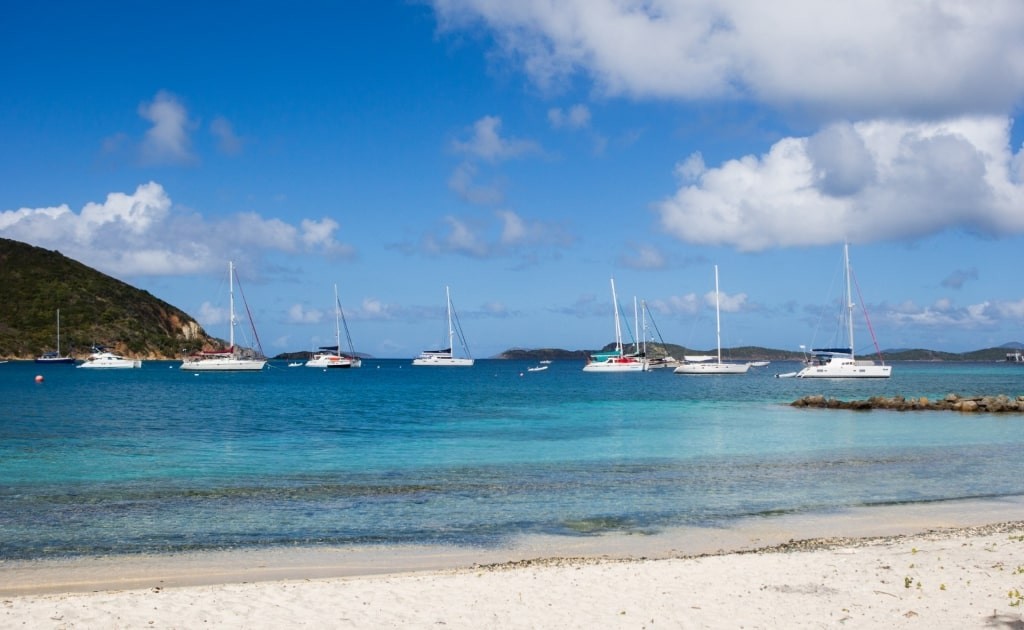Planning a trip to the US Virgin Islands (USVI)? Deciding on the perfect time to visit is key to maximizing your Caribbean getaway. The USVI, encompassing St. Thomas, St. John, and St. Croix, offers distinct experiences throughout the year. This guide breaks down each season, helping you pinpoint the best time to travel to the US Virgin Islands for your ideal vacation.
Summer in the USVI (June – August)
Summer in the USVI is characterized by warm and sunny days, perfect for beach lovers and water enthusiasts. Average temperatures hover around 84℉ (29℃), creating ideal conditions for swimming, snorkeling, and scuba diving in the crystal-clear waters. While all three islands enjoy sunshine, St. Croix and St. Thomas tend to be the driest during these months, each averaging about 2.5 inches (63.5mm) of rainfall monthly. St. John sees slightly more precipitation, around 3.4 inches (86 mm) per month. High temperatures can reach between 89℉ (31.6℃) and 90℉ (32℃). Summer presents an excellent opportunity to explore the stunning beaches the USVI are famous for.
 Magens Bay in St. Thomas, US Virgin Islands, showcases its stunning beauty during the summer months, highlighting why it's a great time to visit.
Magens Bay in St. Thomas, US Virgin Islands, showcases its stunning beauty during the summer months, highlighting why it's a great time to visit.
Fall in the USVI (September – November)
Fall marks the rainiest period in the US Virgin Islands. While temperatures remain warm, averaging around 82℉ (28℃), with highs potentially reaching 89 to 90℉ (31.6 to 32 ℃) in September and October, rainfall increases significantly. St. Croix sees an average of 5 inches (127mm) of rain per month in the fall. St. Thomas and St. John experience even wetter conditions, with average monthly rainfall rising to 6 inches (152 mm) and 6.5 inches (165mm) respectively. September and October also fall within the Atlantic hurricane season, so there’s a higher chance of storms during these months. However, even with increased rainfall, there are still plenty of activities to enjoy. Shopping becomes a delightful indoor alternative, with various options across the islands. St. Thomas boasts Havensight Mall and Crown Bay Center, while St. Croix offers boutique-lined streets in Christiansted and Frederiksted. In St. John, Mongoose Junction in Cruz Bay provides unique shopping experiences.
Winter in the USVI (December – February)
Winter is often considered the best time to travel to the US Virgin Islands. The Caribbean islands experience glorious weather during these months, making the USVI a highly desirable sunny escape. The average temperature is a comfortable 78℉ (26 ℃) across St. Thomas, St. Croix, and St. John from December through February, coupled with minimal rainfall. This dry and pleasant weather is perfect for exploring the diverse landscapes and engaging in outdoor activities. Consider hiking in the Virgin Islands National Park on St. John, relaxing on the pristine sands of Magens Bay Beach in St. Thomas, or snorkeling in the Buck Island Reef National Monument off St. Croix, renowned for its underwater beauty. Winter also brings the exciting opportunity for whale watching as humpback whales migrate to the USVI waters to breed and give birth.
 Winter is the best time to travel to US Virgin Islands for activities like snorkeling at Buck Island Reef National Monument, St. Croix.
Winter is the best time to travel to US Virgin Islands for activities like snorkeling at Buck Island Reef National Monument, St. Croix.
Spring in the USVI (March – May)
Spring in the USVI offers balmy days and relatively low rainfall, making it another excellent time to visit. Exploring the islands is particularly enjoyable with comfortable weather conditions. St. Thomas and St. John experience average temperatures around 82℉ (28℃), while St. Croix is slightly cooler. Precipitation remains low throughout March, April, and May. The pleasant weather in spring allows for full enjoyment of beaches and watersports. In St. Croix, kayaking through Salt River Bay National Historical Park or scuba diving at Cane Bay Beach are popular choices. St. Thomas offers Sapphire Beach for kayaking and swimming, while St. John invites visitors to snorkel the underwater trail at Trunk Bay, part of the Virgin Islands National Park.
 Spring in St. John, US Virgin Islands, offers ideal weather for sailing and exploring the beautiful harbors and coastlines by boat, making it a pleasant season to travel.
Spring in St. John, US Virgin Islands, offers ideal weather for sailing and exploring the beautiful harbors and coastlines by boat, making it a pleasant season to travel.
Conclusion
Ultimately, the best time to travel to the US Virgin Islands depends on your priorities. Winter offers the most idyllic weather with sunshine and low rainfall, making it perfect for a classic Caribbean escape. Spring mirrors winter’s pleasant conditions with slightly warmer temperatures. Summer provides the hottest temperatures and is great for beach activities, while fall, although rainier, still offers warmth and fewer crowds. No matter when you choose to visit, the US Virgin Islands promise a memorable tropical vacation.

